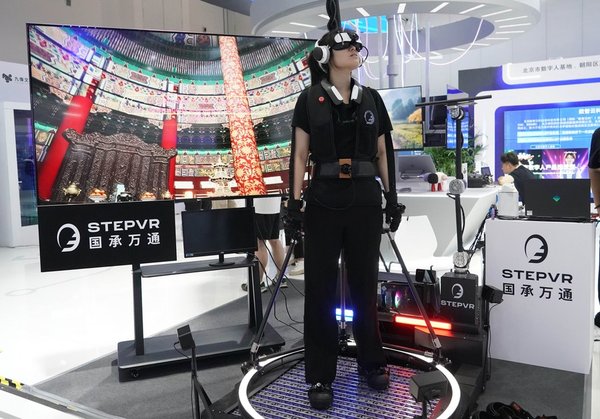Digital Audiovisual Art Fuels China's Culture, Tourism Consumption
 |
| Students watch an immersive show of an artwork at the Tianjin Digital Art Museum in Tianjin, north China, July 30, 2023. [Xinhua/Sun Fanyue] |
BEIJING, Aug. 8 (Xinhua) — The 2023 China Beijing International Audiovisual Conference concluded on Sunday after four days of activities, including the presentation of new technological developments, with art and culture taking center stage.
The event saw more than 200 enterprises and institutions from the global audiovisual industry descend on the Chinese capital to share new development achievements across the entire audiovisual industry chain. Participants set up shops in several dedicated sections, covering a total exhibition area of 20,000 square meters.
Wandering among the booths, visitors were able to gain first-hand experience of the new developments. Through digital technologies, they can view inscriptions on the inside of bronzeware via computer screen, zooming in for a closer look; Chinese characters written on strips of bamboo could be seen flying about in a digital animation. Elsewhere, viewers used digital technology to interact with art installations thousands of miles away.
Among the highlights of the exhibition was the Digital Audiovisual Arts Forum held on Aug. 5, at which experts and industry insiders held discussions on the theme, "The future of digital audiovisual arts in the age of artificial intelligence."
In recent years, with the acceleration of the digitalization of China's culture industry, more and more cultural spaces, including museums, art galleries, theaters and music halls, have presented digital audiovisual content through the integration of culture and digital technology. This development has promoted the cross-border integration of industries, and provided new momentum for novel cultural and tourism consumption.
Jin Jun, a professor at the Central Academy of Fine Arts, said that the development of science and technology has given birth to many new art forms, including AI interaction, light-and-shadow immersion and so on. Support from technology has brought multisensory art experiences to audiences, while classic works can be recreated through digital means, enriching traditional content and revitalizing classic art, said Jin.
Zhang Lie, associate professor of Tsinghua University, said that immersive space and digital creativity are currently very popular topics within the industry. In recent years, he said, with more and more young China-Chic product lovers, the audiovisual arts have played an increasingly important role in tapping into and promoting traditional cultural materials.
Multi-modal interactive digital audiovisuals break the limitations of visual and sound fields, achieving an immersive experience of substituting the roles of virtual and real, turning the learning or visiting process into an exploratory activity, which is quite interesting and entertaining, the professor added.
 |
| A staff member displays a set of VR-powered omnidirectional treadmill at an exhibition during the Global Digital Economy Conference 2023 at the China National Convention Center in Beijing, capital of China, on July 4, 2023. [Xinhua/Ren Chao] |
"Museums have become a paradise for digital innovation, which makes them easier for audiences to access and participate in, helping them understand complex concepts. Through artistic narrative methods, digital audiovisual has opened up a new imaginative space for on-site cultural and tourism experiences," Zhang explained.
The digital audiovisual industry has become an important component of China's digital economy in recent years. The added value of Beijing's culture industry accounts for more than 10 percent of its GDP, while the development prospects of the audiovisual industry are promising.
In late July, China's top economic planner rolled out a slew of measures to boost consumption amid efforts to sustain economic recovery and promote high-quality development. The country vowed to spur consumption of a wide range of items and services, including within the culture and tourism sectors, according to a notice issued by the National Development and Reform Commission.
The notice also mentioned the need to enrich culture and tourism consumption, create new immersive entertainment spaces, and build new culture and tourism consumption clusters.
Sun Hui, secretary general of Tencent's cultural tourism industry research institute, said that digital art can help promote the extension of traditional cultural and tourism resources to multiple forms of digital assets, while innovating the content experience, increasing brand value and fueling business growth.
"Beijing has proposed the building of a globally influential audiovisual industry center, and digital audiovisual art will play a major part in the process," said Kong Jianhua, deputy head of the Beijing Municipal Radio and Television Bureau.
Digital audiovisual art will be integrated into the cultural space of the entire city and help shape the cultural image of Beijing in the future, Kong added.
(Source: Xinhua)
Please understand that womenofchina.cn,a non-profit, information-communication website, cannot reach every writer before using articles and images. For copyright issues, please contact us by emailing: website@womenofchina.cn. The articles published and opinions expressed on this website represent the opinions of writers and are not necessarily shared by womenofchina.cn.






.jpg)

 WeChat
WeChat Weibo
Weibo 京公网安备 11010102004314号
京公网安备 11010102004314号